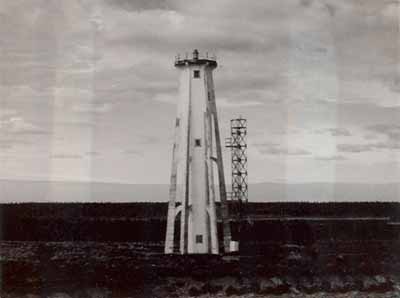Light Tower
Recognized Federal Heritage Building
Bagot Bluff, Quebec

General view
(© Parks Canada Agency / Agence Parcs Canada.)
Address :
Île-Anticosti, Bagot Bluff, Quebec
Recognition Statute:
Treasury Board Policy on Management of Real Property
Designation Date:
1991-05-30
Dates:
-
1912 to 1912
(Construction)
Event, Person, Organization:
-
Department of Marine and Fisheries
(Architect)
Custodian:
Fisheries and Oceans Canada
FHBRO Report Reference:
89-173
DFRP Number:
08031 00
Description of Historic Place
The Light Tower stands tall in its isolated setting at Bagot Bluff on the barren shores of Anticosti Island. It is a white, hexagonal tower of reinforced concrete comprised of a central column supported by flying buttresses. No decorative elaboration detracts from the clarity of its strong vertical thrust. A shorter, steel skeleton tower stands immediately adjacent to the tower on its site. The designation is confined to the footprint of the building.
Heritage Value
The Light Tower is a Recognized Federal Heritage Building because of its historical associations, and its architectural and environmental value.
Historical Value
The Light Tower is associated with the expansion of the navigation system within Canada for the provision of coastal navigational aid. As the steamship trade grew, increasing the number of shipwrecks on this island, it was necessary to install more powerful lights. This 1912 tower succeeded another originally established in the 1870s on the eastern tip of the island.
Architectural Value
The Light Tower is an excellent example of innovative design, construction and application of materials that combines experimental engineering with good aesthetic design. The Light Tower exhibits the functional precision and scale of the buttressed reinforced-concrete tower design developed and employed by the Department of Marine and Fisheries between 1906 and 1912, under the direction of Colonel William Anderson, Chief Engineer. His groundbreaking application of reinforced concrete construction to tall structures gained international attention. The buttresses, employed to counteract a lateral thrust, braced the tower against the horizontal wind load common to windswept sites.
Environmental Value
The Light Tower is compatible with the maritime character of its remote coastal setting and is a familiar landmark to seagoing vessels in this area.
Sources: Martha Phemister, Lighttower, Bagot Bluff, Ile d’Anticosti, Québec, Federal Heritage Buildings Review Office, Building Report, 89-173; Lighttower, Ile du Havre Aubert, Iles de la Madeleine, Québec, Heritage Character Statement, 90-249.
Character-Defining Elements
The character-defining elements of the Light Tower should be respected.
Its good aesthetic and excellent functional design and good craftsmanship and materials, for example: the tall massing of the hexagonal structure with a lantern platform; the distinctive, tapered profile and pleasing form created by its flying buttresses and its crisp simplified lines; the reinforced concrete structure; the small window openings; the whitewashing.
The manner in which the Light Tower is compatible with the present maritime character of its remote coastal setting and is a familiar landmark, as evidenced by: its overall scale, massing, design and materials, which harmonize with its barren, natural and isolated surroundings; its physical prominence from the water, which contributes to its role as a seacoast marker.
Heritage Character Statement
Disclaimer -
The heritage character statement was developed by FHBRO to explain the reasons for the designation of a federal heritage building and what it is about the building that makes it significant (the heritage character). It is a key reference document for anyone involved in planning interventions to federal heritage buildings and is used by FHBRO in their review of interventions.
The Bagot Bluff lighthouse was built in 1912 by the Canadian Department of Marine and Fisheries. It is the property of Transport Canada, Canadian Coast Guard. See FHBRO Building Report 89-173.
Reasons for Designation
The lighthouse was designated a Recognized heritage building because it exhibits the functional precision and scale of the buttressed reinforced concrete tower design developed and employed by the Department of Marine and Fisheries between 1906 and 1912. While isolated and inaccessible by land, the Bagot Bluff lighthouse is a physically prominent structure from the water.
Character Defining Elements
The heritage character of the lighthouse is defined by the visible exterior elements of the structure, its functional design, and its location and setting.
The exterior elements are characterized by the six "flying" buttresses that encircle the hexagonal, concrete structure. The appearance has been compromised however, by the loss of the original lantern. The exterior should be maintained so that the distinctive and pleasing form of the buttressed tower and its crisp simplified lines are retained. Regular whitewashing will protect the concrete from the harsh elements and help maintain the incisive line of this type of lighthouse.
The physical prominence of the lighthouse from the water is increased by the lack of vegetation and other visual obstructions. The overall barrenness of the site should be maintained. The profile of the lighthouse is marred currently by the intrusive steel skeleton tower immediately adjacent. Should it be feasible from a functional point of view, the steel tower should be moved away from the lighthouse.